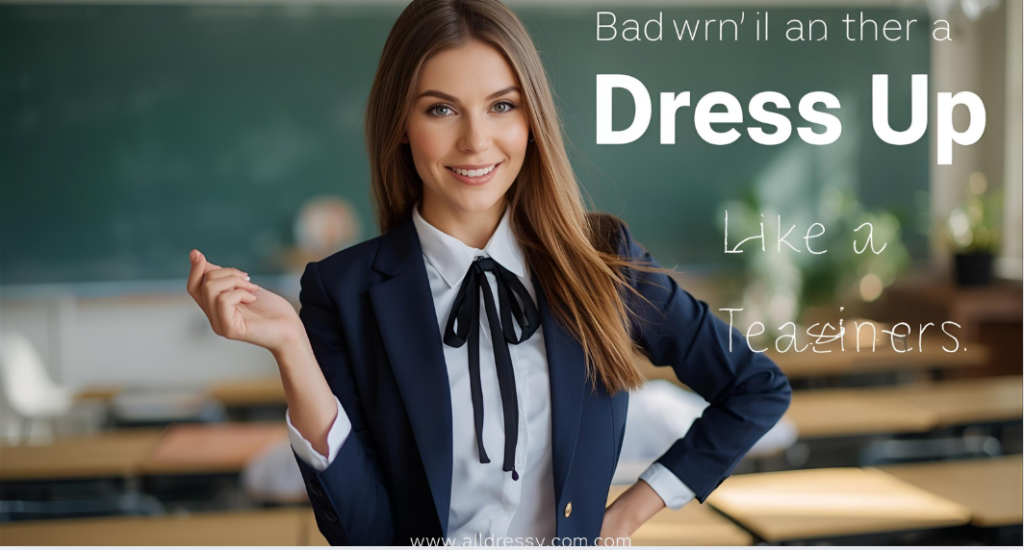Dressing professionally as an educator is more than a necessity—it’s a reflection of your personality, confidence, and authority in the classroom. Learning how to dress up like a teacher allows you to balance professionalism, comfort, and approachability. Whether you’re a new teacher starting your career or a seasoned educator refreshing your wardrobe, understanding the art of teacher styling can make a lasting impression on both students and colleagues.
In this comprehensive guide, we’ll explore wardrobe essentials, outfit ideas, color schemes, accessory tips, seasonal styling, and grooming advice. We’ll also include FAQs and practical tips to ensure that dressing up like a teacher is effortless yet polished.
🌟 Why Dressing Like a Teacher Matters

Dressing professionally as an educator serves multiple purposes:
- Establishes authority: A polished appearance communicates professionalism and respect.
- Builds credibility: Students, parents, and colleagues are more likely to take you seriously.
- Enhances confidence: When you feel good about your appearance, your confidence in the classroom grows.
- Maintains comfort: Teacher-friendly fashion blends style with comfort, allowing you to move freely.
- Promotes a positive classroom environment: Professional attire sets the tone for respect and discipline.
Your wardrobe is part of your teaching toolkit—well-chosen outfits can make your workday smoother and more enjoyable.
👗 Key Principles for Dressing Like a Teacher

When planning your teacher wardrobe, keep these principles in mind:
- Comfort is key: Teachers move a lot, so clothes should allow flexibility.
- Professionalism first: Stick to polished and neat outfits; avoid overly casual items.
- Balance style and modesty: Avoid overly revealing clothing while keeping the look stylish.
- Neutral and versatile colors: Incorporate navy, black, beige, gray, and soft pastels.
- Layer smartly: Blazers, cardigans, and vests help you adapt to changing classroom temperatures.
- Focus on clean lines: Well-fitted and wrinkle-free clothing looks more professional.
🧵 Essential Teacher Wardrobe Pieces
A teacher’s wardrobe should be versatile, comfortable, and stylish. Here’s a breakdown of essential pieces:
1. Blouses and Shirts
- Button-down shirts or blouses with subtle prints or solid colors.
- Breathable fabrics like cotton, linen, or silk blends.
- Avoid low-cut or overly sheer tops.
2. Sweaters and Cardigans
- Lightweight cardigans for layering.
- Pullover sweaters in neutral or soft colors.
- Knit textures add warmth and style for fall and winter.
3. Dresses and Skirts
- Knee-length or midi dresses in solid colors or subtle patterns.
- A-line or shift dresses for comfort and professional appeal.
- Skirts should be knee-length or longer; pair with tights in cooler months.
4. Pants and Trousers
- Tailored trousers or ankle-length pants in neutral shades.
- Comfortable fabrics like stretch cotton or wool blends.
- Avoid overly tight or casual pants like leggings unless styled professionally.
5. Blazers and Jackets
- Classic tailored blazer adds instant polish.
- Light jackets or vests for layering in transitional seasons.
- Neutral or soft pastel colors work well for a professional yet approachable look.
🎨 Color Schemes and Patterns for Teachers
Color and pattern choices are important for dressing like a teacher:
- Neutral tones: Black, navy, gray, beige, white – convey professionalism.
- Soft pastels: Light pink, baby blue, lavender – create approachability and warmth.
- Patterns: Polka dots, stripes, or subtle florals add personality without distraction.
- Avoid: Loud colors, neon shades, or large bold prints that can overwhelm the classroom environment.
Balancing neutral and soft accent colors creates a polished yet friendly teacher appearance.
👠 Footwear for Teacher-Friendly Fashion
Footwear is crucial because teachers spend a lot of time standing or walking:
- Comfortable flats: Ballet flats, loafers, or moccasins.
- Low-heeled shoes: Pumps or block heels for a professional look without discomfort.
- Boots: Ankle or knee-high boots for colder months; avoid overly high heels.
- Sneakers: Stylish, minimalist sneakers can work for casual or active days if school policy allows.
Prioritize supportive and durable shoes that complement your outfits.
👜 Accessories to Complete the Teacher Look
Accessories should enhance your outfit without overpowering it:
- Watches: A classic watch conveys punctuality and professionalism.
- Jewelry: Minimalist earrings, rings, or bracelets.
- Scarves: Lightweight scarves add style and can be layered creatively.
- Bags: Structured tote or handbag that can hold classroom essentials.
Accessories are small details that can elevate your outfit from basic to stylish and professional.
🧑🎓 Outfit Ideas to Dress Like a Teacher
Here are practical outfit combinations to help you dress up like a teacher:
1. Classic Business Look
- Blouse tucked into tailored trousers
- Blazer in a neutral color
- Low-heeled pumps
- Minimalist jewelry
2. Casual Yet Polished
- Cardigan layered over a patterned blouse
- A-line skirt or ankle-length pants
- Ballet flats
- Subtle scarf for added style
3. Creative & Approachable
- Midi dress with soft floral prints
- Light blazer or cardigan
- Loafers or ankle boots
- Statement necklace or simple earrings
4. Comfortable and Functional
- Stretch cotton trousers
- Pullover sweater in pastel shade
- Stylish yet comfortable sneakers
- Tote bag for classroom essentials
5. Seasonal Outfits
- Fall/Winter: Knit dress with tights and knee-high boots
- Spring/Summer: Linen blouse with tailored skirt and flats
- Layering pieces like blazers or cardigans ensure adaptability to classroom temperatures
💇 Grooming Tips for Teachers
Professional grooming is essential when dressing like a teacher:
- Hair should be neat and styled appropriately for daily classroom activities.
- Nails should be clean and trimmed; neutral nail polish is best.
- Light, natural makeup for a polished, approachable look.
- Fresh breath and subtle fragrance maintain professionalism.
A clean and tidy appearance complements your clothing and leaves a lasting impression on students, parents, and colleagues.
🌿 Seasonal Tips for Teacher Fashion
Adjust your wardrobe for comfort and style throughout the year:
1. Spring/Summer
- Lightweight fabrics like cotton or linen
- Bright, soft colors for a welcoming feel
- Dresses or skirts with short sleeves
2. Fall/Winter
- Layer with cardigans, sweaters, and blazers
- Tights, long sleeves, and warm boots
- Neutral tones or muted colors for a professional look
Seasonal adjustments ensure comfort without compromising professionalism.
⚠️ Common Mistakes to Avoid When Dressing Like a Teacher
- Wearing overly casual items like ripped jeans or t-shirts.
- Choosing uncomfortable shoes that affect mobility.
- Over-accessorizing with large or flashy jewelry.
- Dressing too revealing or flashy, which may distract students.
- Neglecting grooming and personal care.
- Wearing bright, distracting colors that clash with a professional setting.
💬 FAQs About How to Dress Up Like a Teacher
1. Can teachers wear dresses and skirts?
Yes, knee-length or midi dresses and skirts are appropriate when paired with modest tops and comfortable shoes.
2. How can teachers dress comfortably yet professionally?
Opt for stretch fabrics, low-heeled shoes, and layered outfits to maintain professionalism while allowing freedom of movement.
3. Are bright colors acceptable for teachers?
Yes, in moderation. Use pastel or soft shades to appear approachable without compromising professionalism.
4. Can teachers wear accessories?
Yes, but keep them minimal. Watches, earrings, and scarves are ideal. Avoid anything distracting or noisy.
5. How should male teachers dress?
Dress shirts, trousers, blazers, and polished shoes create a professional and approachable look. Layering and subtle accessories like ties or watches work well.
6. What shoes are best for long teaching days?
Comfortable flats, low heels, loafers, or supportive ankle boots are ideal. Avoid high heels or unsupportive shoes.
7. Can teachers wear sweaters and cardigans?
Absolutely! Layering with sweaters or cardigans is practical and stylish for cooler months.
8. Should teachers follow fashion trends?
Yes, but subtly. Incorporate trends in colors, patterns, or accessories without compromising professionalism.
9. How do teachers choose the right outfit for parent-teacher meetings?
Opt for business casual or semi-formal outfits like a blazer with trousers or a polished dress. Neutral colors and minimal accessories are recommended.
10. How do teachers balance style and authority?
Combine professional wardrobe staples with subtle personal touches like scarves, prints, or jewelry to convey approachability and confidence.
💖 Conclusion: Dress Like a Teacher With Confidence
Learning how to dress up like a teacher is about finding the balance between professionalism, comfort, and personal style. A polished appearance builds confidence, credibility, and authority in the classroom while remaining approachable to students.
Key takeaways:
- Focus on comfort and practicality without compromising style.
- Use neutral and soft colors for a professional yet approachable appearance.
- Layer with cardigans, blazers, and sweaters for versatility.
- Choose supportive and stylish footwear.
- Accessorize minimally and maintain proper grooming.
By following these guidelines, dressing like a teacher becomes effortless, ensuring that your professional image aligns with your expertise, confidence, and classroom presence. A well-styled teacher is not just noticed—they inspire confidence and respect in every classroom interaction.

